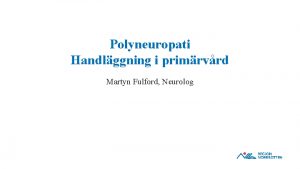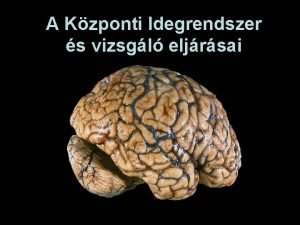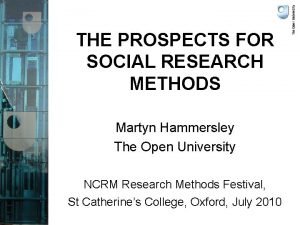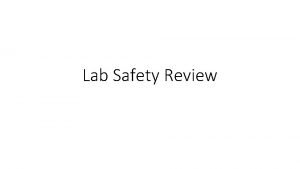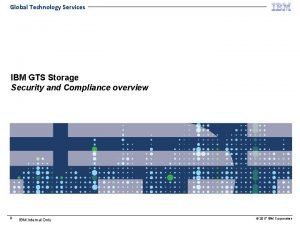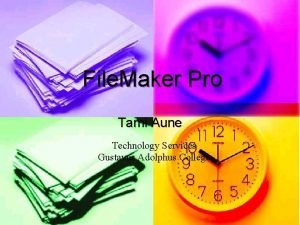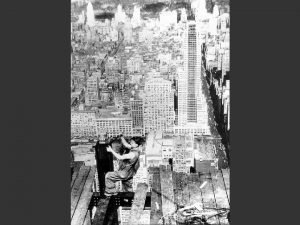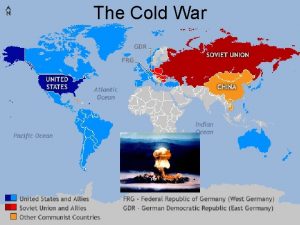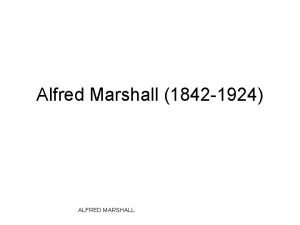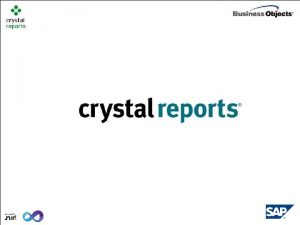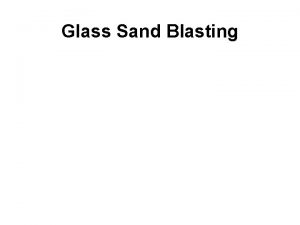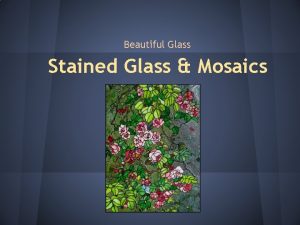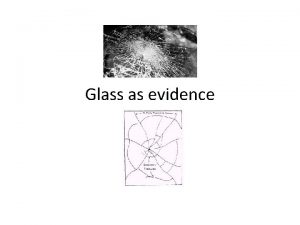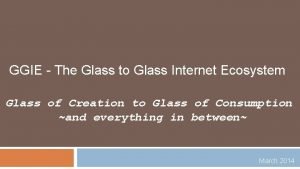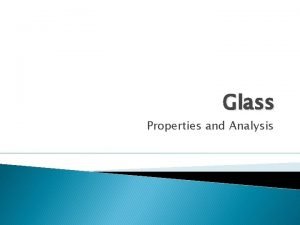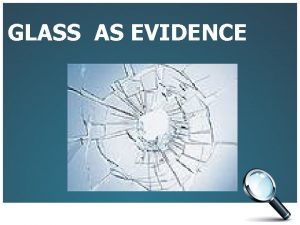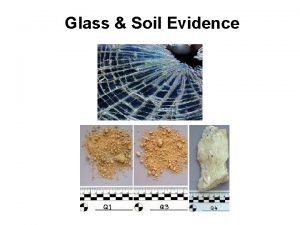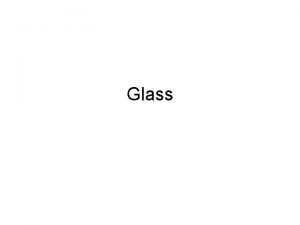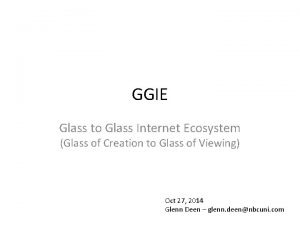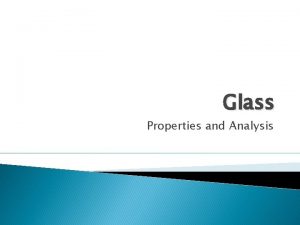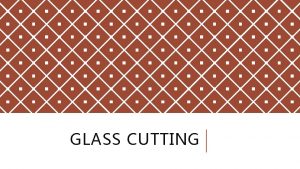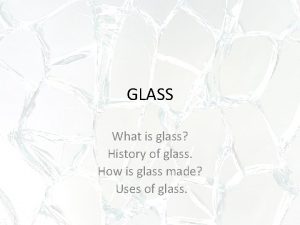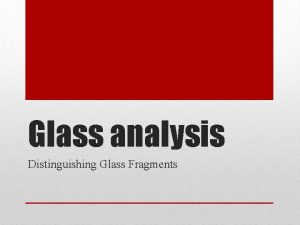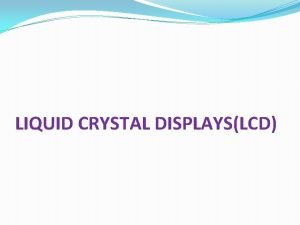Martyn Marshall Glass Technology Services Introduction Crystal glass













































- Slides: 45

Martyn Marshall Glass Technology Services

Introduction Crystal glass is famed for its clarity, a water white colour and a sparkling lustre that is hard to find in any other glass Anything that could affect this represents a problem for the glassmaker All glass picks up contamination during manufacture

Cullet Batch Materials Pot Corrosion

Colouring Impurities The literature gives the following as upper limits acceptable in crystal glass Impurity Cobalt oxide Nickel oxide Chromium oxide Copper oxide Iron oxide Manganese oxide Vanadium oxide Maximum Level wt% 0. 0005 (5 ppm) 0. 0005 0. 001 0. 1

Batch Mixing

Refractory Corrosion The majority of refractory materials are mineral based and so contain iron as a constituent, as the pot corrodes during melting this iron gets into the glass and may cause problems with the colour

Decolourising Glass No matter how careful the glass maker is, there will be iron present in the glass, Cullet Raw Materials Refractory Corrosion Provided the iron level is below 0. 05% decolourising is a viable option

Decolourising Glass There are two factors to consider in the effective decolourising of crystal glass Chemical Decolourising Physical Decolourising

Chemical Decolourising Iron oxide in glass can be present as either ferric or ferrous iron The ferric form is the oxidised Fe 3+ ion The ferrous form is the reduced Fe 2+ ion The transmission curves of each are very different

Curve 1 Ferric Fe 3+ ion Curve 2 Ferrous Fe 2+ ion

Ferrous or Ferric The Fe 2+ / Fe 3+ ions exist in equilibrium in the glass, affected by the redox of the batch and the melting of the glass The aim then is to drive the Fe 2+ / Fe 3+ towards the paler ferric form This is done by adding oxidising agents to the batch

Physical Decolourising Having shifted the equilibrium towards the ferric form, the glass may still have a pale green tint The second part of decolourising is the masking of this physical colour

Complimentary Colours Violet Red Blue Orange Blue Green Yellow Green

100 80 60 40 20 300 400 500 600 Wavelength (nm) 700

Measuring Colour Once we understand the importance of colour in crystal glass we need to then begin to measure the phenomena. We can then use the results to improve the glass

Looking at Colour The hardest part of colour measurement is matching the performance of the human eye itself The eye can determine around 10 million different colours and has a specific sensitivity


Measuring Colour CIE ( Commission Internationale D’ Eclairage) was first introduced in 1931 The system is based on additive colour mixing

Measuring Colour The three basic colours are red, green and blue, these form the RGB co-ordinates Measuring the colour requires a standard light source and a standard observer CIE have a series of observers, based on situations such as incandescent light, noon sunlight and overcast sky daylight


Measuring Colour Originally the colours were determined by using specific coloured filters The colour measurement is now generated by manipulating the data from the transmission spectra of the glasses This plots the % of light passed at each specific wavelength

Measuring Colour Once we have the raw data in the computer we can begin to look at comparative measurements If we are interested in the colour, or lack of it in the glass, can we assess the whiteness?

Measuring Colourlessness or ‘whiteness’ of crystal glass is vitally important A number of whiteness measures exist and need be applied to transparent materials such as glass rather than the reflective measures used in the colourant industry

Measuring Colour Common whiteness scales include those of Hunter, Berger and one developed specifically for flint container glass The system for container glasses ranked colours by observers and corrected the whiteness measure to match those observers

Measuring Colour Simple measures based on CIE RGB did not provide a match A new set of parameters was devised from the CIE data which fitted the perceived whiteness The measure could be used for crystal but was developed specifically for container glass

Measuring Colour Determining the whiteness gives a measure of the glass useful for quality control A colour change will change the whiteness but will not tell us how the colour has changed This means we cannot rectify the problem and return the glass to specification

Measuring Colour described using the CIE (x, y, Y) co-ordinates is shown on a chromaticity diagram

Measuring Colour The CIE chart has been adapted several times over the years but retains this format. The major problem with colour measurement is the element of colour perception Determining the dominant wavelength and purity of the colour from CIE allows for this

G D S

Measuring Colour Using data in the CIE form has drawbacks The first is the non uniform nature of the plot, colours seen as equally different are not equally spaced on the chromaticity diagram The second is the central region for faint or achromatic colours is small

Measuring Colour To overcome the distortion of the CIE diagram uniform colour spaces have been developed Two common uniform colour spaces exist The CIELUV system is used in the television industry The CIELAB system is used by the colourants industry

Measuring Colour CIELAB transforms the (x. y, Y) values into (a, b, L) there a is the red: green, b is the blue: yellow and L is the luminance or brightness Using LAB it is possible to identify exactly any colour

CIELAB diagram

Measuring Colour CIELAB is a useful tool for following changes in glass colour All the data can be manipulated electronically rather than graphically as is the case with a number of whiteness measures

Measuring Colour 0. 5 0. 4 Standard 0. 3 Glass 1 Glass 3 Glass 2 -0. 15 -0. 10 -0. 05 0. 00 0. 2 0. 1 0. 05

Measuring Colour We can follow the progress of more significant changes in colour using the original CIELAB system A refinement of the CIELAB works best with similar colours close to the origin

Measuring Colour The data here is transformed into modified Adams co-ordinates, using the coding L, a, b L represents the Luminance, a is red / bluegreen and b is yellow / purple This shifting of the colours delineates the points closer to the origin




Measuring Colour The control of colour is vitally important within the crystal industry Spectroscopic measurements of the glass can provide invaluable data This can be used to determine the both the colour and the whiteness of the glass

Measuring Colour 1 2 3 4 Management Strategy Visual standards from production Whiteness measure for customer information CIELAB for significant shifts in colour Modified Adams co-ordinates for refined colour measurement

Measuring Colour Monitoring the colour is a vital part of the manufacturing process but it needs to be allied with control of the batch, the cullet and the melting as well as the control of the decolourising mixture for the glass

Martyn Marshall Glass Technology Services

 Iron and glass architecture
Iron and glass architecture Quartz crystal technology
Quartz crystal technology Crystal india domestic services
Crystal india domestic services Martyn fulford
Martyn fulford Our love now
Our love now Martin doolard
Martin doolard Martyn pig film
Martyn pig film John martyn harlow
John martyn harlow Martyn fulford
Martyn fulford Martyn kingsbury
Martyn kingsbury Martyn hammersley
Martyn hammersley Harald haradra
Harald haradra Tuppy owen smith
Tuppy owen smith Martyn kingsbury
Martyn kingsbury Martyn owen
Martyn owen Martyn rogers
Martyn rogers Craig martyn
Craig martyn Glass ceiling vs glass escalator
Glass ceiling vs glass escalator If an acid is splashed on your skin, wash at once with
If an acid is splashed on your skin, wash at once with Does hot glass look like cold glass
Does hot glass look like cold glass Financial services technology consortium
Financial services technology consortium Ibm support services
Ibm support services Ibm cbm
Ibm cbm Gts global technology services
Gts global technology services Web service technology stack
Web service technology stack Gustavus technology services
Gustavus technology services Head of information technology
Head of information technology Global technology services
Global technology services Global technology services
Global technology services Welcome to ccs
Welcome to ccs Colt technology services revenue
Colt technology services revenue Lovesets manoeuvre
Lovesets manoeuvre Marshall plan significance
Marshall plan significance Marshall lernerov uvjet
Marshall lernerov uvjet John marshall randolph
John marshall randolph Vivian burey marshall
Vivian burey marshall Truman doctrine marshall plan
Truman doctrine marshall plan Marshall bermann
Marshall bermann Satellite nations
Satellite nations Cuban missile crisis apush
Cuban missile crisis apush Http://www-bcf.usc.edu/~gareth/isl/advertising.csv
Http://www-bcf.usc.edu/~gareth/isl/advertising.csv Rumus indeks walsh
Rumus indeks walsh John marshall middle school
John marshall middle school Terms of trade formula
Terms of trade formula Marshall pickens hospital
Marshall pickens hospital Mconline login 2020
Mconline login 2020



